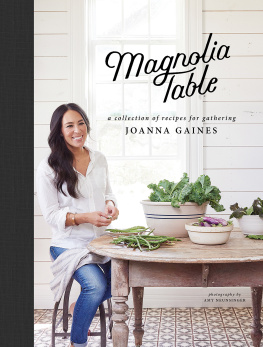Contents
Guide
To my mother:You have taught me that a home-cooked meal is a warm extension of love and care for your family. Some of my fondest memories are with you in the kitchen, and many of my favorite meals are the ones you and I have made side by side.To my mother-in-law, Gayle:The way youve always opened up your home to family, friends, and even strangers has inspired me over the years to be intentional about the details when it comes to making my own dinner table a place for people to gather and feel welcome. Contents
Its no secret that Im a creature of habit. When I find a routine, a rhythm, or really
anything at all that works and feels right, I cling to it with two steady hands. It is precisely the sure and steady part of my personality that has always been drawn to food, less for the thrill of a really good flavor combination or the plentiful health benefits, both of which I have grown to place great value in, but more because food, to me, has long represented comfort and familiarity. When Ive been far from home, or just moved into a
new home, whipping up a familiar family recipe would instantly give me a sense of place, wherever I happened to be. Ideally in the form of cheesy bread and homemade dumplingsor, better yet, chocolate cake! Back when Chip and I were young parents, raising four kids under the age of four, food became a survival tool, a physical means of nourishing six bodies three times a day.
I longed for easy, not new, so I leaned in to the food I grew up with, the no-fail recipes that I could be confident I wouldnt mess up while four hungry babies stared up at me. During those years, dinner was rarely elaborate or impressive. But it was, on most days, the only time we could all sit around the table and be intentional about sharing a meal together. I started to notice a pattern that followed this nightly rhythm: When dinner was served, the house quieted, stories were told, and when it was time to excuse ourselves, everyone was fed in more ways than one. If not for the warm food on the table, those sacred evenings wouldnt have happened. And so, every day, it seemed, I found myself anticipating dinner around the table, which soon turned into thinking ahead about what I might serve and how I could set the table to make dinnertime feel a little more special.
And thats when I began to see the kitchen differentlyfor what it had to offer my family beyond being the place where we stored our produce and stacked our plates. What had once been a place I often dreaded, I now saw as a gift, there to equip me with the space and tools I needed to make these meals possible. So, slowly, I began to spend more time in our kitchen, messing with ingredients and practicing using new tools and recipes. I was still a ways away from feeling confident in this space, but something deep inside me told me that the life that was happening around our table every night was worth the effort. I started to pay attention to the foods my kids favored and practiced making meals that would support, but also oftentimes challenge, their palates. Gradually, I started to feel like I actually belonged in this space.
Though there was, and still is, plenty of ordering in on nights when I just dont feel like cooking or when a meal inevitably burns. That mind-set shift was a pivotal turning point for me. It led me to actually enjoy the creative part of cooking a meal, but even more, it opened my eyes to how much I treasured what came nextwhen everyone gathered around the tablewhether it was among family, friends, or mixed company. Since then, it has been the soul and substance that resounds at the tableof stories being told while glasses clink and hands pass bowls, the excitement that murmurs when I confirm there is in fact dessert tonight, and always the lingering conversationsthat has made the table itself one of the most familiar places in my world. The life that unfolds around it day after day continues to be potent enough to draw me back again and again. My first cookbook, Magnolia Table, was a celebration of this very thing, an ode to bringing people around the table with recipes I knew intimately and had used to gather loved ones around my own table for years.
From the start, I knew that I wanted to fill its pages with all my favorites: really good, easy-to-execute recipes that I had been relying on for years, including dishes from dear friends or favorite recipes from family traditions. Once that book was put out into the world, and I saw so many of you making the same recipes that have been around my own table, friends tables, and tables of generations past, it impressed upon me a profound commitment to the value of food being shared, of worn-in recipes being handed down. Watching my familys favorite meals become a part of the fabric of your families taught me so much more than I thought I knew about the power of food. Yes, food is personal. Yes, it can nourish our bodies. But it can also bridge strangers across state lines and beyond language barriers.
My familys dinner table became hitched to yours, and yours became hitched to the table of someone entirely new. And the old adagea shared table is a shared lifenever felt more true. But this experience was entirely unlike the first. In short: This book stretched me. Because most of my tried-and-true recipes were already out in the world, this process required me to get in the kitchen and start from scratch. This time around, my team and I worked to develop new recipes, which required me to study cooking in a way that I never had in order to learn how to go about refining dishes that Id always craved but couldnt put a name to. Once again, I was faced with an opportunity to push myself beyond my comfort zone and stretch my palate.
On many days, standing in my kitchen flour-clad and deep in recipe development took me back to those early years in my first tiny kitchen, giving myself pep talks when it came to learning how to use new tools and discern ingredients. But just as I eventually realized back then, within the safety of my own walls, I felt free to try and fail and make messes. Both times, confidence was earned by trial and error; and both times have reminded me that a sweet reward of cooking is not only in whats created, but also in the simple act of getting to create. For this, I have become convinced that there should always be space for grace in the kitchenalong with plenty of takeout menus. While it would certainly be the easy choice to fill a week of dinners with my familys favorite dishes and call it good, deep down thats not what I want for any of us. Taking a chance on ourselves and trying something new is how we get to experience possibility and how we stay enamored with the world around us.
Being open to change and growth refines who we are and makes us all more gracious and understanding humans. And who knows, it might even lead to raising kids who become the kind of adults who love to bring people around their own tables. To me, those things make being stretched worth it, even when it goes against every natural fiber of my being. But because growth by its very nature requires change, and I dont get to have one without the otherthey are wisely and intricately woven togetherit means being willing to learn from those who know more than I do, and to invite my food tastes and preferences to evolve. So thats what I did. I tried and failed, and I tried again, and every week we got closer and closer.
Next page


















